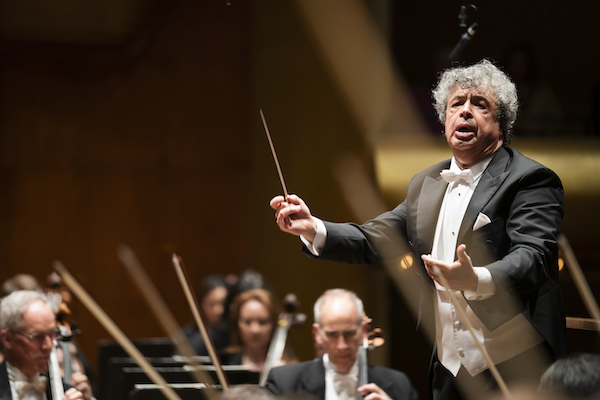A pair of tragic symphonies with varied results from Bychkov, Philharmonic

Semyon Bychkov conducted the New York Philharmonic in music of Brahms and Thomas Larcher Wednesday night at David Geffen Hall. Photo: Chris Lee
At Wednesday’s concert of the New York Philharmonic, sober reflection and orchestral virtuosity came in the same package. Twice.
Semyon Bychkov led a program consisting of two substantial symphonies–Thomas Larcher’s No. 2, Kenotaph, and Johannes Brahms’s No. 4—that had much in common: a tragic character, and truly “symphonic” ambitions when it came to orchestral sonorities and breadth of expression.
Not to mention the four-movement form of Haydn and Beethoven—sonata-allegro, slow movement, scherzo, finale—which was considered old-fashioned when Brahms took it up for the fourth and last time in 1884, never mind Larcher in 2015.
The goal was to put stimulating new wine in that old bottle, and we now know that Brahms succeeded four times over. And Wednesday’s U.S. premiere of Larcher’s harrowing symphony showed it can still be done.
It came as no surprise that a 21st-century composer turned to the percussion section for fresh orchestral sonorities, a passel of players manning dozens of strikeable, shakeable, and bowable objects large and small. Accordion, prepared piano, and slide whistles were among the other exotic visitors.
What was perhaps more surprising was how much of the sound of Brahms and Strauss lived on in Larcher’s imagination as he sought to address “developments we have been part of during our lifetime”—specifically, Europe’s ongoing immigration crisis.
In brief remarks from the stage before the performance, the Austrian composer took note of events that have mostly disappeared from U.S. news media, pushed aside by immigration controversies closer to home. But the desperate attempts of North African and Middle Eastern refugees to reach Europe in small, overloaded vessels continue unabated, resulting in an average of six deaths at sea every day, even as European governments curtail their rescue efforts.
The symphony, the composer said, was a cenotaph, a monument to the distant dead. The work opened in a burst of agitation amid constantly shifting meters, driven by wood percussion and expertly managed by conductor Bychkov, the symphony’s dedicatee. Melancholy episodes of darkly Romantic hue alternated with urgent ostinatos and furious climaxes clanging with metal percussion. Strings swooned and soared amid roars of tam-tam and thunder sheet.
A feeling of exhaustion pervaded the Adagio, as the orchestra’s lowest-pitched instruments intoned a subterranean chorale. A slow climb through keening chromatic lines led to a fierce episode, the orchestral sound swelling to a full-bodied fortissimo before the chorale returned softly in low brass, set off by Ivesian polytonal tinkles in high instruments and bells.
Whip and metallic sounds drove the frenetic scherzo, as the orchestra veered from its ripest sound to its most attenuated effects. Dialogues between sections—strings with percussion, double basses with woodwinds—were smartly executed. At the close, a long accelerando like a train gathering speed led to a moment of Bartókian irony, a few gently dancing bars of Austrian ländler.
Another European musical tradition, the chromatic chorale settings of Bach, glimmered faintly in the finale’s slow introduction for strings. The agitated mood returned, softly at first, then punctuated by bursts of percussion, brass, and winds as the music accelerated to a furious climax. A sudden, desolate pianissimo followed, and the symphony dwindled to silence in the lowest strings and winds.
Larcher’s richly imagined piece, and the first-rate execution by Bychkov and the Philharmonic musicians were greeted at the end with only respectful applause, just enough to bring the composer onstage for a couple of quick bows. Many a dissonant new work has fared better than this with the orchestra’s subscribers.
Maybe they were impatient to get to Brahms. If so, their priorities proved misplaced. For the first three of its four movements, in Wednesday’s performance, Brahms’s Fourth stubbornly refused to come into focus.
Bychkov led the orchestra with generalized gestures, as if conducting the broad sweep of a Tchaikovsky symphony rather than the chiseled ideas of Brahms, and as a result the music moved along in undifferentiated fashion from bar to bar, missing many a magical shift of tone color or harmony in the Andante and most of the locker-room hijinks of the Scherzo.
Some fine moments of wind lines interweaving were outnumbered by unbalanced passages in which Brahms’s superb melodies were covered by subordinate parts. (At least Bychkov was able to shush the horns with an outstretched palm to give the violins a chance in the first movement’s second theme.)
So it was a pleasure, and a relief, to hear all the pieces fall into place for the finale’s craggy theme and picturesque variations. The conductor attended to the unique character of each variation without losing the movement’s overall thread. Wind solos soared unimpeded. Trombones glowed. Each section spoke clearly when its turn came. The music gathered momentum in the closing pages, ending this somber symphony with a stark E minor cadence, cut off exactly on time. The audience responded with a storm of applause and accolades for the solo players.
The program will be repeated 7:30 p.m. Thursday and Tuesday and 8 p.m. Saturday. nyphil.org; 212-875-5656.